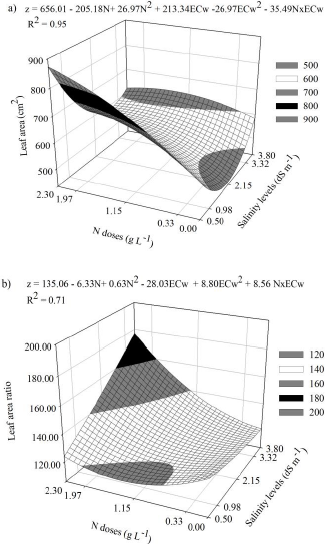1. Introduction
For the world agricultural sector, one of the current concerns, which is among the main causes of the depletion of agricultural areas, has been the salinity in irrigated soils. It is estimated that approximately 20% of irrigated areas have already been affected and more than 75 countries are experiencing problems with salinity [1-3].
In Brazil, the scenario is no different. In the region with a semi-arid climate, the risks are imminent, and, in many cases, the water used for irrigation has high salt concentrations due to high annual evapotranspiration and low rainfall, in addition to the use of irrigation practices without a drainage system [4,5].
Salt stress induces osmotic stress, which limits the absorption of water in the soil by the plant and, as a result, causes nutritional imbalance due to high concentrations of potentially toxic salts [6]. The accumulation of ions at toxic levels also interferes with physiological processes such as photosynthesis, nitrogen fixation, respiration and starch metabolism. This can result in a reduction in the production of plant biomass and, consequently, in crop yield [7-9].
The passion fruit (Passiflora edulis Sims. f. flavicarpa) crop has great production potential in the Brazilian semi-arid region, with the Northeast responsible for 62.31% of the national production; however, in these areas the management of this crop is dependent on irrigation and the water used contains large amounts of salts [10,11]. Deleterious effects of salinity on the morphophysiological aspects of yellow passion fruit plants have been reported by [12,13].
In order to minimize the effects of salinity on production systems, research has been studying the nutritional supply with essential elements that can provoke positive responses in plant species under salt stress [14-17].
Nitrogen triggers vital functions in plants, serving as a constituent of many plant cell components, including chlorophyll, amino acids, and nucleic acids, being essential for plant growth [6]. The application of this element in a balanced way can reduce the effect of salinity on plants, since the accumulation of this organic solute increases their capacity of osmotic adjustment, increasing the resistance of crops to water and salt stresses [18].
In view of the need for methods that mitigate the harmful effects of salinity on agricultural crops and the importance of information regarding the influence of nitrogen fertilization on yellow passion fruit, this research study aimed to analyze the influence of foliar nitrogen fertilization on growth and photosynthetic pigments of passion fruit seedlings irrigated with saline water.
2. Materials and methods
2.1. Description of the experimental area
The experiment was conducted between April and June 2019 under protected environment conditions at the Center for Agricultural Sciences, Federal University of Paraíba, Campus of Areia, Paraíba, Brazil. It is located at the geographical coordinates 6° 58’ 00’’ S latitude and 35° 41’ 00’’ W longitude, at 575 meters altitude. The climate of the region is As', which means dry and hot summer and rains in winter, according to Köppen’s classification [19].
2.2. Experimental design
As an experimental design, randomized blocks were used, with four replicates and two plants per plot. The treatments consisted of the combination of five electrical conductivities of irrigation water (ECw) (0.50; 0.98; 2.15; 3.32; 3.80 dS m-1) and five doses of foliar nitrogen fertilization (0.0; 0.30; 1.15; 1.97; 2.30 g L-1), obtained through the Box’s Central Composite matrix [20].
2.3. Plant material
In the sowing, seeds of yellow passion fruit (Passiflora edulis f. Flavicarpa) were used, as it has a high yield and consumer market acceptance. The experiment was carried out in polyethylene bags with a capacity of 1.2 dm3, where 5 seeds per bag were sown, with thinning after the establishment of the emergence, leaving only one plant per container.
The passion fruit seedlings were produced in polyethylene bags, with a capacity of 1.2 dm3, filled with substrate composed of 85% soil, 10% fine sand and 5% aged manure.
2.4. Characterization of the substrate
The substrate was analyzed for physical and chemical characteristics based on fertility and salinity, following the methodologies of [21] and [22] presenting the chemical characteristics: pH = 7.8; P = 85.5 mg kg-1; K+ = 693.6 mg kg-1; Na+ = 0.23 cmolc dm-3; H+Al+3 = 0.0 cmolc dm-3; Al+3 = 0.0 cmolc dm-3; Ca+2 = 2.9 cmolc dm-3; Mg+2 = 1.59 cmolc dm-3; SB = 6.5; CEC = 6.5 g kg-1; O.M. = 22.2 g kg-1.
2.5. Preparation of electrical conductivities for irrigation water and fertilization
The electrical conductivities of irrigation water were obtained by diluting the dam water, strongly saline (14.6 dS m-1), in non-saline water (0.5 dS m-1), with the aid of a portable conductivity meter. Salinity levels were chosen based on [14], who observed inhibition in the growth of passion fruit seedlings from the ECw of 1.5 dS m-1.
Despite the lack of work on foliar fertilization in seedlings, the nitrogen doses were chosen following the recommended dose of 300 mg of N dm-3 proposed by [23]. The nitrogen requirement was supplied through a commercial product based on urea, composed of 99 g L-1 of nitrogen.
Irrigation with saline water started 20 days after sowing (DAS), carried out daily manually, according to the need of the crop. The volume applied in each irrigation was determined based on the drainage lysimetry process, providing the volume of evapotranspired water daily, in order to raise the soil moisture content to the level of field capacity. For that, 10 bags were selected to determine the water capacity supported by the container, using collectors, based on the difference between the volume applied and the volume drained from the previous irrigation [24]. Every 15 days, a 10% leach fraction was applied based on the corresponding volume in the period, in order to reduce the accumulation of salts in the substrate.
2.6. Application of foliar fertilization
Still at 20 DAS, fertilizations with nitrogen started, which were divided into 7 foliar applications, carried out weekly, by means of sprayers, at the end of the afternoon. These applications ended at 62 DAS, with a total volume of 175 ml applied per plant, consisting of making available 0, 58.16, 200, 341.84 and 400 mg of nitrogen per plant according to the increase of the evaluated doses. The product was diluted in distilled water on the day of application, according to the treatments.
2.7. Variables evaluated
The evaluations were performed at 75 DAS, by determining the chlorophyll a, chlorophyll b, total chlorophyll and chlorophyll a/b ratio, by the non-destructive method, using a portable chlorophyll meter (ClorofiLOG®, model CFL 1030, Porto Alegre, RS), with the values measured in the Falker chlorophyll index (FCI).
In the same period, the following growth variables were also evaluated: plant height, with a millimeter-graduated ruler; stem diameter, with digital caliper; number of leaves, by counting; and leaf area and leaf area ratio, estimated according to [25], using eqs. 1 and 2:
Where: LA = leaf area, L = length (cm), W = width (cm) of each leaf and “f” = Factor 0.6544.
Where: LAR = leaf area ratio (cm2 g-1), SDP = shoot dry phytomass (g), LA = leaf area (cm²).
2.8. Statistical analysis
The data were subjected to analysis of variance and polynomial regression analysis, using the statistical program R [26].
3. Results and discussion
3.1. Biometric Parameters
The analysis of the biometric variables of passion fruit revealed that plant height was influenced by the interaction between ECw and nitrogen doses through the leaves. The maximum increment observed was in plants that were fertilized with the dose of 2.13 g L-1 of nitrogen through the leaves and irrigated with water of up to 0.50 dS m-1, where 94.03 cm was quantified, reaching an increase of 57.6% when compared to the lowest value (39.90 cm), observed in plants that did not receive nitrogen through the leaves (0.0 g L-1) and received ECw of up to 2.04 dS m-1 (Fig. 1). [5] also observed that nitrogen fertilization favored the development of passion fruit seedlings and mitigated the effects of excess salts up to ECw of 2.0 dS m-1 for plant height.
Regarding the isolated effects of nitrogen doses, a quadratic behavior was found for the variables number of leaves and stem diameter, with the largest increments of 10.21 leaves per plant and 4.62 mm in diameter being recorded at doses 0.84 g L-1 and 1.13 g L-1 of nitrogen through the leaves, respectively (Fig. 2A and 2B).
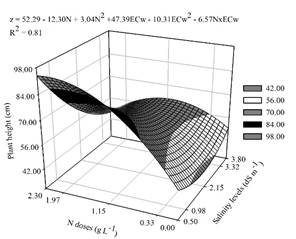
Source: The authors.
Figure 1 Response surface of height of passion fruit seedlings, subjected to electrical conductivities of irrigation water (z axis) and doses of foliar nitrogen fertilization (x axis).
These increases in the growth parameters of passion fruit can be justified by the fact that nitrogen favors a greater supply of photoassimilates, participating in vital structures and processes of plants, which is fundamental for their growth and development [27,28].
Similar results for passion fruit plants were reported by [29] who found a quadratic effect for the variable number of leaves under nitrogen fertilization, and by [30] who reported values of 4.1 mm in diameter, as a function of the nitrogen doses.
The electrical conductivity of irrigation water up to 3.80 dS m-1 reduced the number of leaves by 10.66% (Fig. 2C) and stem diameter by 10.51% (Fig. 2D), with values on the order of 10.51 leaves per plant and 4.85 mm in diameter, when compared to the control treatment. Reductions in the number of leaves and stem diameter of passion fruit plants were reported by [31] and [32] when there was an increase in irrigation water EC up to 2.8 dS m-1 and 3.2 dS m-1, respectively.
These reductions can occur when the salt concentration increases, decreasing the osmotic potential of the solution, compromising the absorption of water [33] and thereby interfering in the water relations of plants, which negatively affects the balance of nutrients [34].
For leaf area, greater increments occurred in plants under the dose of 2.30 g L-1 of nitrogen through the leaves and under the ECw of 0.50 dS m-1, obtaining 869.79 cm2 (Fig. 3A).
As for the leaf area ratio, the deleterious effects of irrigation water salinity were mitigated by a dose of 2.30 g L-1 of nitrogen through the leaves up to the ECw of 3.80 dS m-1, where the value of 176.53 cm2 g-1 was quantified (Fig. 3B). Since nitrogen is an essential element, [35] reported that this nutrient stimulates the production of leaf biomass and leaf area in passion fruit plants, which promotes a beneficial effect on the growth and quality of seedlings.
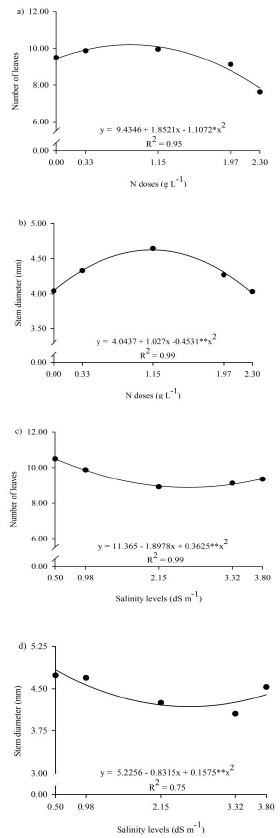
Source: The authors.
Figure 2 Number of leaves (A and C) and stem diameter (B and D) of passion fruit seedlings, submitted to foliar nitrogen doses and electrical conductivities of irrigation water.
3.2. Physiological Parameters
For the chlorophyll a index, there was an increase of 21.02% as a function of the applied nitrogen doses via the leaf, obtaining a maximum value (34.21) at the dose of 1.99 g L-1 and a minimum value (27.02) at the dose of 0.0 g L-1 (Fig. 4A). Nitrogen is an essential element in the structure of the chlorophyll molecule and a constituent of amino acids [6], so there is a high correlation between its content and chlorophyll in plant leaves.
With the increase of ECw up to 3.80 dS m-1, a linear reduction in chlorophyll a indexes is noted, with a value of 29.70, representing a reduction of 17.36% (Fig. 4B). Similar results were observed by [38] for passion fruit plants and in different species grown under salt stress conditions, such as Vigna Unguiculata L. [39], Gossypium hirsutum L. [40] and Zea mays L. [41].
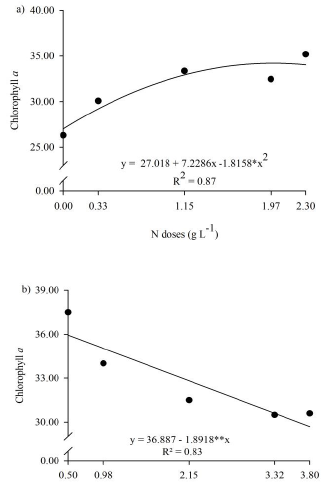
Source: The authors.
Figure 4 Chlorophyll a (A and B) of passion fruit seedlings submitted to nitrogen doses and electrical conductivities of irrigation water.
Reductions in chlorophyll a indexes, due to salt stress, imply a lower capacity for absorbing light from the environment by the proteins of the reaction center of photosystem I [42]. This may be due to the advanced breakdown of chlorophyll molecules or the impeded chlorophyll biosynthesis, since the increased activity of the enzyme chlorophyllase is responsible for the reduced content of chlorophyll, since chlorophyllase catalyzes the degradation of chlorophyll molecules [43].
The deleterious effects of irrigation water salinity on chlorophyll b and total chlorophyll were mitigated by the foliar application of the nitrogen dose of 2.30 g L-1 at ECw of 0.50 dS m-1, where values were quantified in 16.71 and 58.15 reaching increases of 63.28% and 41.84% when compared to the minimum values obtained at ECw of 2.20 and 2.03 dS m-1 and at the dose 0.0 g L-1 of nitrogen through the leaves, respectively (Fig. 5A and 5B).
The attenuation of he deleterious effects of salinity by nitrogen may have occurred due to the importance of thiselement for chlorophyll, since it promotes a greater accumulation of organic compounds, playing an important role in the osmotic balance, in addition to being a constituent of chlorophyll molecules, amino acids and proteins [28, 34]. The results found in this study for the levels of chlorophyll b and total chlorophyll do not corroborate those observed by [44] as these authors did not observe the effects of nitrogen doses on the content of passion fruit pigments.
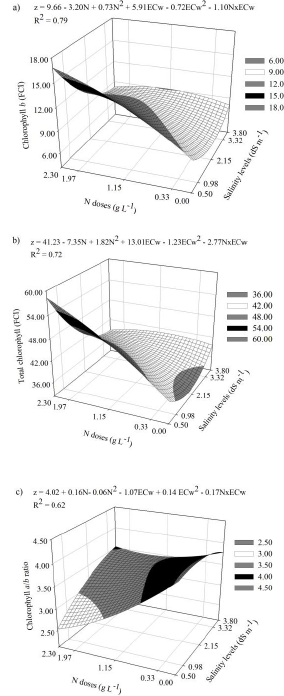
Source: The authors.
Figure 5 Response surface of chlorophyll b (A), total chlorophyll (B) and chlorophyll a/b ratio (C) in passion fruit seedlings subjected to different electrical conductivities of irrigation water (z axis) and doses of nitrogen (x axis).
For the chlorophyll a/b ratio, an interaction was observed between the dose 0.0 g L-1 of nitrogen through the leaves and the ECw of 1.36 dS m-1, with a value of 4.13 being quantified, and the lowest results observed at dose of 2.30 g L-1 of nitrogen through the leaves and at ECw of 0.50 dS m-1 (Fig. 5C). The opposite result for the chlorophyll a/b ratio of passion fruit was described by [10] who reported a 12.6% reduction with the increase in the electrical conductivity levels of the water.
It is observed that the highest value for chlorophyll a/b ratio in this work was obtained in the absence of nitrogen and under intermediate doses of ECw. [45] explain that this behavior can occur as a plant defense mechanism, where there is an increase in the number of thylakoids or chloroplasts, generating the activation of a protection mechanism to the plant’s photosynthetic system.
4. Conclusion
Foliar application of nitrogen attenuates the deleterious effects of irrigation water salinity on plant height, leaf area, leaf area ratio, chlorophyll b, and total chlorophyll of passion fruit; The absence of foliar nitrogen fertilization (0.0 g L-1) and the electrical conductivity of the irrigation water of 1.36 dS m-1 increase the chlorophyll a/b ratio;
Foliar application of nitrogen (0.84 g L-1; 1.13 g L-1 and 1.99 g L-1) promotes the highest values for the number of leaves, stem diameter and chlorophyll a, respectively; The increase in the electrical conductivity of the irrigation water decreases the number of leaves, stem diameter and chlorophyll a index.
















